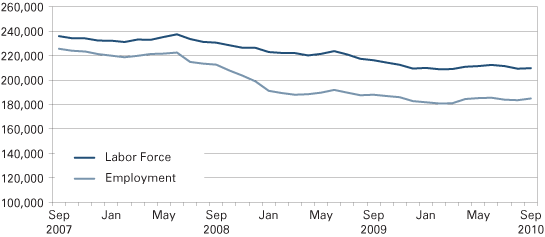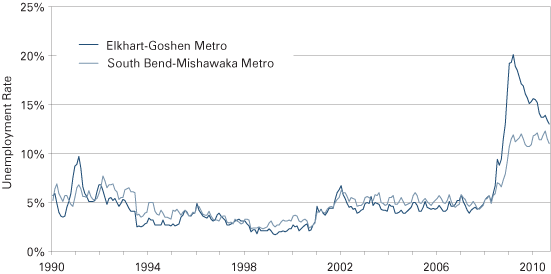South Bend and Elkhart Area Forecast 2011
Chair and Professor of Economics, School of Business and Economics, Indiana University South Bend
Associate Editor, Indiana Business Research Center, Kelley School of Business, Indiana University
The Michiana region, which includes the Elkhart-Goshen MSA and the South Bend-Mishawaka MSA,1 is still recovering from the 2007-2009 recession2 and has begun to enjoy vigorous business growth despite the weak economy. This trend toward recovery is likely to continue throughout 2011.
Employment
After a fairly steady drop in the labor force the past few years, the 2010 data for the combined Elkhart-Goshen and South Bend-Mishawaka MSAs indicate a leveling out in the area’s labor market.3 While the labor force continued its decline, it is declining at a slower rate, with a drop of about 6,500 workers from September 2009 to September 2010 (see Figure 1); the prior year’s decline was more than double that figure.
Figure 1: Labor Force and Employment in the Elkhart-Goshen and South Bend-Mishawaka MSAs Combined, September 2007 to September 2010

Note: Data are not seasonally adjusted.
Source: IBRC, using Bureau of Labor Statistics data
The Elkhart-Goshen MSA had some of the worst unemployment rates in the nation during the recession, warranting visits from President Obama in early 2009.4 The Elkhart-Goshen unemployment rate peaked in March 2009 at 20.1 percent and has since dropped to 13 percent in September 2010, still high but definitely an improvement (see Figure 2).
Figure 2: Unemployment Rates in the Elkhart-Goshen and South Bend-Mishawaka MSAs, January 1990 to September 2010

Note: Data are not seasonally adjusted.
Source: IBRC, using Bureau of Labor Statistics data
The South Bend-Mishawaka MSA did not see as drastic a climb in its unemployment rate, though it is still much higher than it was pre-recession at 11 percent in September 2010. This metro has a notably lower concentration in manufacturing than the Elkhart-Goshen MSA that likely contributed to its less drastic jump. As both metropolitan areas improve in 2011, the unemployment rate should decline to 9.5 percent in the South Bend-Mishawaka metro and 11 percent in the Elkhart-Goshen area.
Table 1 shows employment data by industry for the Michiana region. While jobs in the MSAs are still down 46,500 from where they were in September 2007, a look at the more recent data shows some positive signs. Combined total nonfarm jobs were down 1,500 (-0.6 percent) in September 2010 compared to their September 2009 levels. That may not sound all that positive unless one considers that nonfarm employment dropped 6.5 percent from 2007 to 2008 and 10.4 percent from 2008 to 2009 (using data from September of each year). Thus, it looks like the worst is behind us and job losses are moderating.
Table 1: Employment by Industry and Metro Area, September 2010
| Industry | Elkhart-Goshen | South Bend-Mishawaka | Combined | ||||
|---|---|---|---|---|---|---|---|
| Employment | Change since September 2009 | Employment | Change since September 2009 | Employment | Change since September 2007 | Change since September 2009 | |
| Total Nonfarm | 100,100 | 1,000 | 130,500 | -2,500 | 230,600 | -46,500 | -1,500 |
| Natural Resources, Mining and Construction | 3,300 | -100 | 4,800 | -400 | 8,100 | -3,000 | -500 |
| Manufacturing | 40,600 | 1,100 | 15,900 | 0 | 56,500 | -25,800 | 1,100 |
| Trade, Transportation and Utilities | 15,800 | 200 | 25,600 | 200 | 41,400 | -5,600 | 400 |
| Information | 600 | 0 | 1,700 | -100 | 2,300 | -600 | -100 |
| Financial Activities | 3,200 | 100 | 5,900 | -300 | 9,100 | -1,100 | -200 |
| Professional and Business Services | 6,500 | 0 | 12,000 | 400 | 18,500 | -4,800 | 400 |
| Private Educational and Health Services | 11,300 | 0 | 31,100 | -1,500 | 42,400 | -1,700 | -1,500 |
| Leisure and Hospitality | 6,600 | 0 | 11,800 | 0 | 18,400 | -1,800 | 0 |
| Other Services | 3,100 | -200 | 5,100 | -200 | 8,200 | -1,600 | -400 |
| Government (Includes Public Schools and Hospitals) | 9,100 | -100 | 16,600 | -600 | 25,700 | -500 | -700 |
Source: Bureau of Labor Statistics
Individual industries saw some positive signs as well in the more recent data. While every industry saw losses from September 2007 to September 2010, three industries in the combined area experienced job gains over the past year—manufacturing; trade, transportation and utilities; and professional and business services. While leisure and hospitality did not gain any jobs from 2009 to 2010, it did not lose any either.
All of the manufacturing gains (1,100 jobs) were a result of more jobs in the Elkhart-Goshen MSA, and all the jobs in professional and business services added since 2009 (400 jobs) were a result of gains in the South Bend-Mishawaka MSA. Both MSAs gained equally in trade, transportation and utilities, each adding 200 jobs since September 2009. The biggest losses for the combined area in the past year were seen in educational and health services (-1,500 jobs since September 2009) and government, which includes public schools and hospitals (-700 jobs).
In 2011, we expect overall employment gains of 3.6 percent for the South Bend-Mishawaka and 3.5 percent for the Elkhart Goshen metros. With the exception of government, we expect employment gains in other sectors (see Table 2).
Table 2: Projected Employment Growth for Selected Industries, 2011
| Industry | South Bend-Mishawaka | Elkhart-Goshen |
|---|---|---|
| Education and Health | 3.2% | 2.6% |
| Trade, Transportation, and Utilities | 1.9 | 2.5 |
| Manufacturing | 3.1 | 3.6 |
| Professional and Business Services | 3.3 | 2.3 |
| Leisure and Hospitality | 1.7 | 3.0 |
| Financial Activities | 2.5 | 4.0 |
| Natural Resources | 2.1 | 3.0 |
| Other Services | 2.9 | 3.2 |
| Information | 5.0 | 6.6 |
Source: Based on author’s calculations
Wages
Average weekly wages in the combined MSAs were relatively stable from the first quarter of 2009 to the first quarter of 2010, falling only $1 over that time and coming in at $681 for total jobs. Wages did not fall equally in each MSA, however. The Elkhart-Goshen MSA actually saw an increase in wages of 3.4 percent. The South Bend-Mishawaka MSA experienced an overall decline in wages of 2.8 percent. Eight industries in the Elkhart-Goshen MSA contributed to its overall increase in average weekly wages, with the highest contributors being management of companies and enterprises (up 24.6 percent to $2,042/week) and manufacturing (up 10 percent to $760/week).
Housing
From January to September 2010, the Elkhart-Goshen MSA had 128 single-family building permits filed, higher than its January to September 2009 number of 104. Meanwhile, the South Bend-Mishawaka MSA had fewer single-family building permits filed through September of 2010 (130) compared to 162 filed during the same time period in 2009. Elkhart-Goshen saw over-the-year increases in every month from February to July 2010 while South Bend-Mishawaka experienced its only over-the-year increase in March. The region should experience modest growth in housing demand due to the expected upturn in economic activity, stabilized financial markets and lower mortgage rates. Continued tight credit conditions and high local unemployment will work against this growth.
Summary
In 2010, the Michiana region continued to work against the sluggish economy that started in 2007: job loss, high unemployment rates and weak new home construction. However, 2010 showed some positive signs, with unemployment rates continuing to fall, slower employment decline than in previous years (with increases in some industries) and a less dramatic drop in wages over the previous year (with increases in some industries).
Looking ahead, we’re beginning to see some vigorous business expansions like the Ignition and Innovation Parks in South Bend, new contracts for 2,526 Humvees, the airport expansion at the South Bend Regional Airport, recovery in the RV industry, and new businesses such as Think North America, Nexus RV, and others. Overall, we expect Michiana’s economic conditions to improve in 2011 with falling unemployment, modest job growth, improvement in real wages and increased activity in the housing market.
Notes
- Unless otherwise noted, the Elkhart-Goshen MSA includes Elkhart County and the South Bend-Mishawaka MSA is limited to St. Joseph County, Indiana.
- In September 2010, the National Bureau of Economic Research marked the dates of the 2007-2009 recession as December 2007 through June 2009. For more information, visit www.nber.org/cycles/cyclesmain.html.
- Employment data in this section are Local Area Unemployment Statistics data from STATS Indiana and are not seasonally adjusted.
- Mimi Hall, “Obama visits job-starved Elkhart, Indiana,” USA Today, February 9, 2009, accessed November 10, 2010.
Also in this Issue…
- Outlook for 2011
- International Outlook for 2011
- U.S. Outlook for 2011
- Financial Outlook for 2011
- Housing Market Outlook for 2011
- Indiana's Outlook for 2011
- Indiana's Agricultural Outlook for 2011
- Anderson Forecast 2011
- Bloomington Forecast 2011
- Columbus Forecast 2011
- Evansville Forecast 2011
- Fort Wayne Forecast 2011
- Gary Forecast 2011
- Indianapolis-Carmel Forecast 2011
- Kokomo Forecast 2011
- Lafayette Forecast 2011
- Louisville Forecast 2011
- Muncie Forecast 2011
- Richmond Forecast 2011
- South Bend and Elkhart Area Forecast 2011
- Terre Haute Forecast 2011




